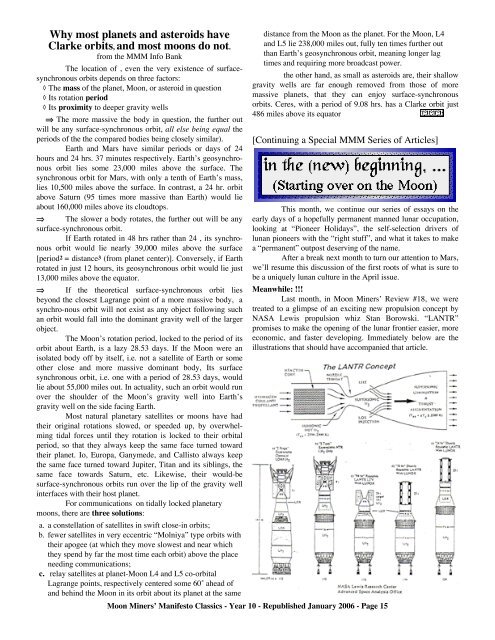MMM Classics Year 10: MMM #s 91-100 - Moon Society
MMM Classics Year 10: MMM #s 91-100 - Moon Society
MMM Classics Year 10: MMM #s 91-100 - Moon Society
Create successful ePaper yourself
Turn your PDF publications into a flip-book with our unique Google optimized e-Paper software.
Why most planets and asteroids have<br />
Clarke orbits, and most moons do not.<br />
from the <strong>MMM</strong> Info Bank<br />
The location of , even the very existence of surfacesynchronous<br />
orbits depends on three factors:<br />
◊ The mass of the planet, <strong>Moon</strong>, or asteroid in question<br />
◊ Its rotation period<br />
◊ Its proximity to deeper gravity wells<br />
fi The more massive the body in question, the further out<br />
will be any surface-synchronous orbit, all else being equal the<br />
periods of the the compared bodies being closely similar).<br />
Earth and Mars have similar periods or days of 24<br />
hours and 24 hrs. 37 minutes respectively. Earth’s geosynchronous<br />
orbit lies some 23,000 miles above the surface. The<br />
synchronous orbit for Mars, with only a tenth of Earth’s mass,<br />
lies <strong>10</strong>,500 miles above the surface. In contrast, a 24 hr. orbit<br />
above Saturn (95 times more massive than Earth) would lie<br />
about 160,000 miles above its cloudtops.<br />
fi The slower a body rotates, the further out will be any<br />
surface-synchronous orbit.<br />
If Earth rotated in 48 hrs rather than 24 , its synchronous<br />
orbit would lie nearly 39,000 miles above the surface<br />
[period 2 = distance 3 (from planet center)]. Conversely, if Earth<br />
rotated in just 12 hours, its geosynchronous orbit would lie just<br />
13,000 miles above the equator.<br />
fi If the theoretical surface-synchronous orbit lies<br />
beyond the closest Lagrange point of a more massive body, a<br />
synchro-nous orbit will not exist as any object following such<br />
an orbit would fall into the dominant gravity well of the larger<br />
object.<br />
The <strong>Moon</strong>’s rotation period, locked to the period of its<br />
orbit about Earth, is a lazy 28.53 days. If the <strong>Moon</strong> were an<br />
isolated body off by itself, i.e. not a satellite of Earth or some<br />
other close and more massive dominant body, Its surface<br />
synchronous orbit, i.e. one with a period of 28.53 days, would<br />
lie about 55,000 miles out. In actuality, such an orbit would run<br />
over the shoulder of the <strong>Moon</strong>’s gravity well into Earth’s<br />
gravity well on the side facing Earth.<br />
Most natural planetary satellites or moons have had<br />
their original rotations slowed, or speeded up, by overwhelming<br />
tidal forces until they rotation is locked to their orbital<br />
period, so that they always keep the same face turned toward<br />
their planet. Io, Europa, Ganymede, and Callisto always keep<br />
the same face turned toward Jupiter, Titan and its siblings, the<br />
same face towards Saturn, etc. Likewise, their would-be<br />
surface-synchronous orbits run over the lip of the gravity well<br />
interfaces with their host planet.<br />
For communications on tidally locked planetary<br />
moons, there are three solutions:<br />
a. a constellation of satellites in swift close-in orbits;<br />
b. fewer satellites in very eccentric “Molniya” type orbits with<br />
their apogee (at which they move slowest and near which<br />
they spend by far the most time each orbit) above the place<br />
needing communications;<br />
c. relay satellites at planet-<strong>Moon</strong> L4 and L5 co-orbital<br />
Lagrange points, respectively centered some 60˚ ahead of<br />
and behind the <strong>Moon</strong> in its orbit about its planet at the same<br />
distance from the <strong>Moon</strong> as the planet. For the <strong>Moon</strong>, L4<br />
and L5 lie 238,000 miles out, fully ten times further out<br />
than Earth’s geosynchronous orbit, meaning longer lag<br />
times and requiring more broadcast power.<br />
the other hand, as small as asteroids are, their shallow<br />
gravity wells are far enough removed from those of more<br />
massive planets, that they can enjoy surface-synchronous<br />
orbits. Ceres, with a period of 9.08 hrs. has a Clarke orbit just<br />
486 miles above its equator<br />
[Continuing a Special <strong>MMM</strong> Series of Articles]<br />
This month, we continue our series of essays on the<br />
early days of a hopefully permanent manned lunar occupation,<br />
looking at “Pioneer Holidays”, the self-selection drivers of<br />
lunan pioneers with the “right stuff”, and what it takes to make<br />
a “permanent” outpost deserving of the name.<br />
After a break next month to turn our attention to Mars,<br />
we’ll resume this discussion of the first roots of what is sure to<br />
be a uniquely lunan culture in the April issue.<br />
Meanwhile: !!!<br />
Last month, in <strong>Moon</strong> Miners’ Review #18, we were<br />
treated to a glimpse of an exciting new propulsion concept by<br />
NASA Lewis propulsion whiz Stan Borowski. “LANTR”<br />
promises to make the opening of the lunar frontier easier, more<br />
economic, and faster developing. Immediately below are the<br />
illustrations that should have accompanied that article.<br />
<strong>Moon</strong> Miners’ Manifesto <strong>Classics</strong> - <strong>Year</strong> <strong>10</strong> - Republished January 2006 - Page 15















